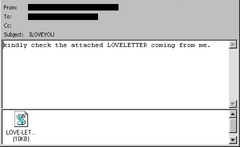| ILOVEYOU | |
|---|---|
 | |
| Email with an infected attachment | |
| Alias | Love Bug, Loveletter |
| Type | Computer worm |
| Origin | Manila, Philippines |
| Authors | Onel de Guzman |
| Technical details | |
| Platform | Windows 9x, Windows NT 4.0, Windows 2000 |
| Size | 10.31 kilobytes |
| Written in | VBScript |
ILOVEYOU, sometimes referred to as the Love Bug or Loveletter, was a computer worm that infected over ten million Windows personal computers on and after 5 May 2000. It started spreading as an email message with the subject line "ILOVEYOU" and the attachment "LOVE-LETTER-FOR-YOU.TXT.vbs".[1] At the time, Windows computers often hid the latter file extension ("VBS", a type of interpreted file) by default because it is an extension for a file type that Windows knows, leading unwitting users to think it was a normal text file. Opening the attachment activates the Visual Basic script. First, the worm inflicts damage on the local machine, overwriting random files (including Office files and image files; however, it hides MP3 files instead of deleting them), then, it copies itself to all addresses in the Windows Address Book used by Microsoft Outlook, allowing it to spread much faster than any other previous email worm.[2][3]
Onel de Guzman,[4] a then-24-year-old computer science student at AMA Computer College[5] and resident of Manila, Philippines, created the malware. Because there were no laws in the Philippines against making malware at the time of its creation, the Philippine Congress enacted Republic Act No. 8792, otherwise known as the E-Commerce Law, in July 2000 to discourage future iterations of such activity. However, the Constitution of the Philippines prohibits ex post facto laws, and as such de Guzman could not be prosecuted.[6]
- ^ Poulsen, Kevin (3 May 2010). "May 4, 2000: Tainted 'Love' Infects Computers". Wired. ISSN 1059-1028. Retrieved 28 July 2021.
- ^ "What is the ILOVEYOU worm, what does it do, and how do I detect and remove it?". University Information Technology Services. 18 January 2018. Retrieved 28 July 2021.
- ^ Mezquita, Ty (3 February 2020). "ILOVEYOU Virus". CyberHoot. Retrieved 28 July 2021.
- ^ Cite error: The named reference
landler2000was invoked but never defined (see the help page). - ^ White, Geoff (12 September 2020). "The 20-Year Hunt for the Man Behind the Love Bug Virus". Wired. ISSN 1059-1028. Retrieved 15 September 2020.
- ^ Caña, Paul John (4 May 2020). "Filipino Creator of the 'I Love You' Virus Just Did It So He Could Get Free Internet". Esquire Philippines. Archived from the original on 7 June 2020. Retrieved 19 January 2021.